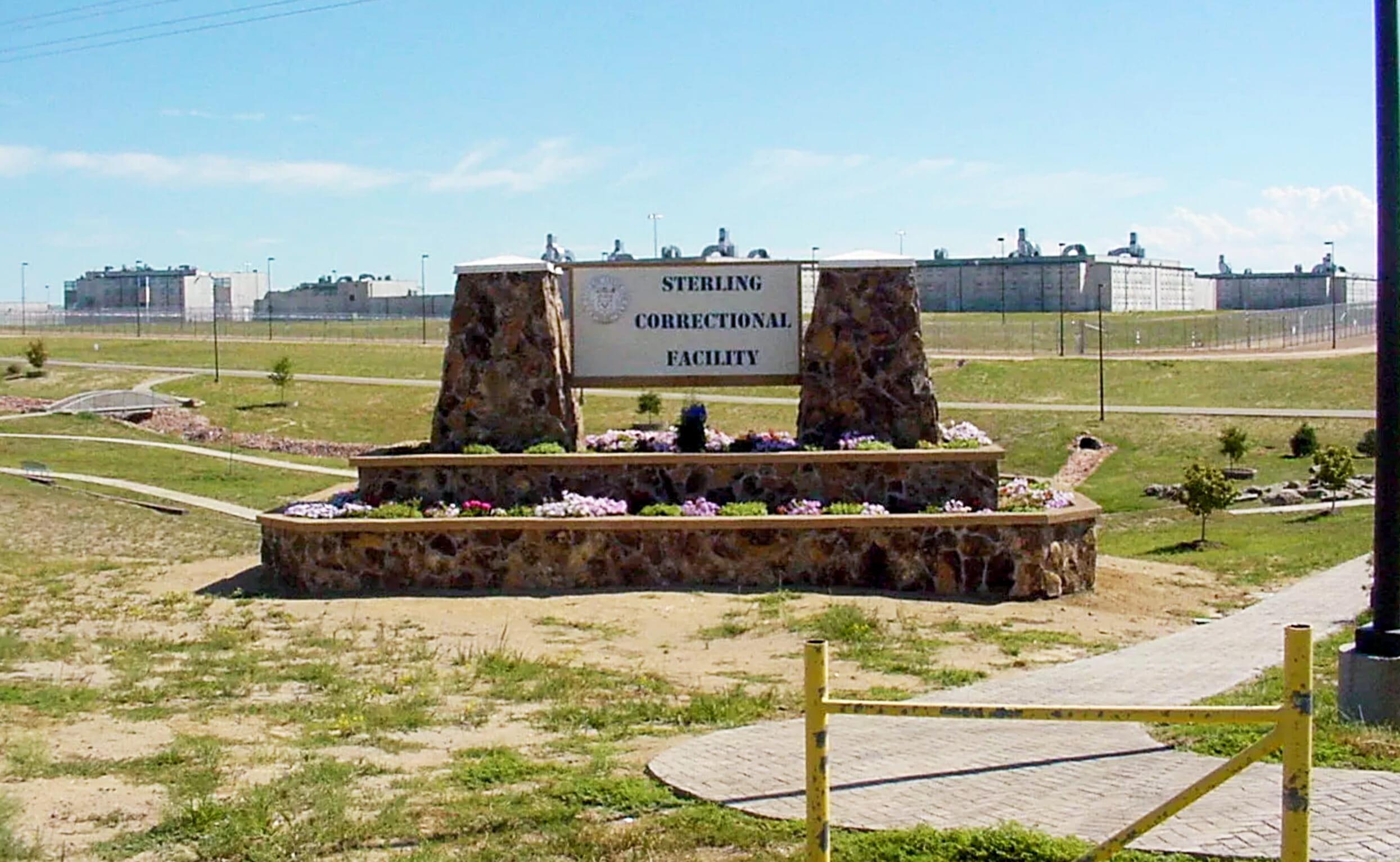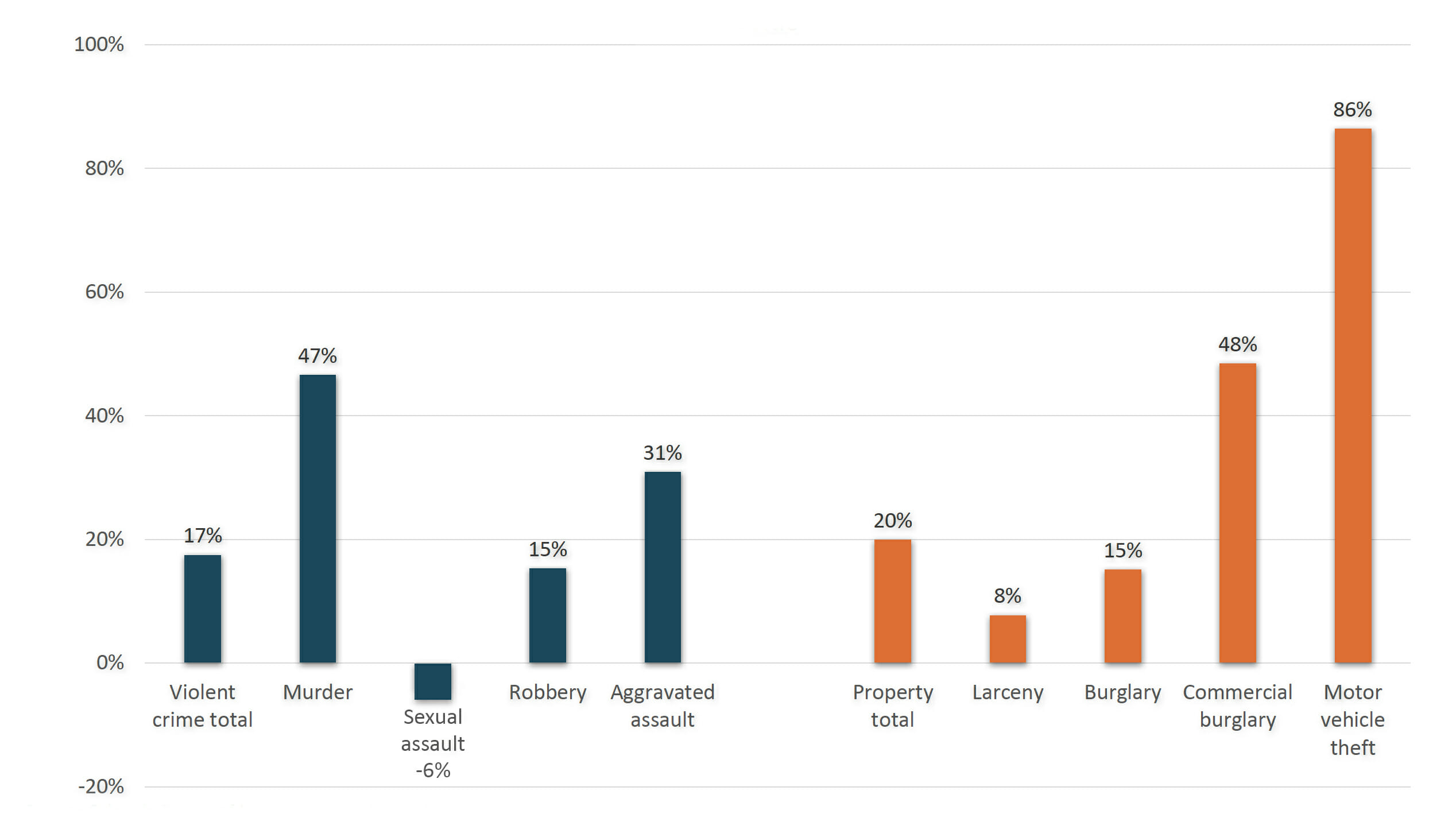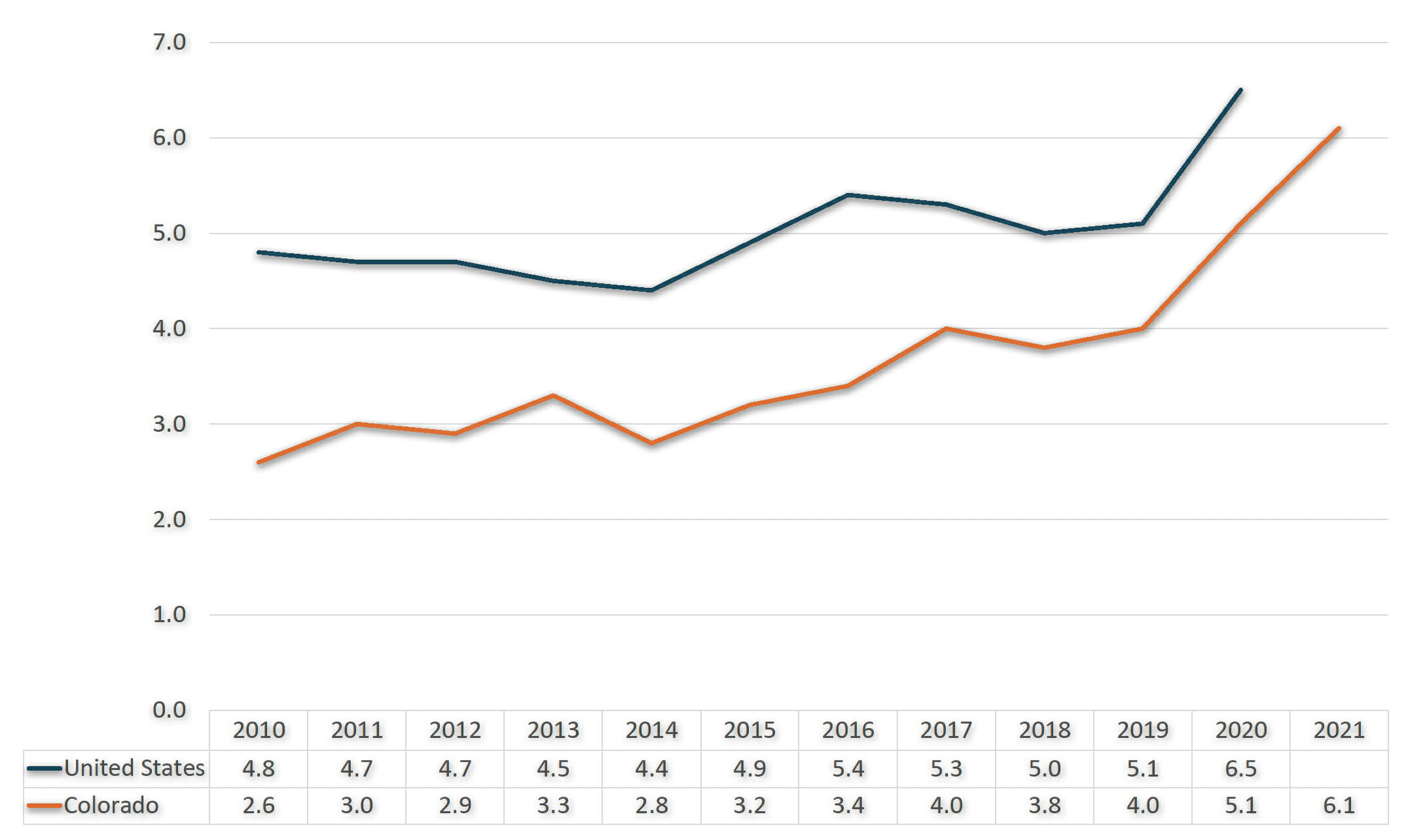
Criminal Justice in Colorado
The following sections examine Colorado’s prisons, crime statistics and trends, recidivism, criminal rehabilitation, incarceration alternatives, and potential future solutions for improving the state’s criminal justice system.
Colorado Prison Population Data
Colorado ranks 29th in the nation for its prison population, with more prisoners per capita than New Mexico but fewer than Kansas.1 According to the National Institute of Corrections, Colorado’s incarcerated primarily serve sentences in state and county jails (13,810 inmates) or state prisons (19,785).2 As a general rule, those serving time in jail are either serving short, relatively minor sentences or are awaiting trial. Inmates in state prisons are usually there post-trial and are serving longer sentences.
It’s worth mentioning that, for much of the 1970s, 80s, and 90s, the jail population and prison population in Colorado steadily climbed at about the same rate. But beginning in the early-2000s, the jail population began to level off, and the prison population continued to increase rather dramatically.
While Colorado’s prison population has begun to fall in recent years, it’s still concerning when a state’s prison population far outmatches its jail population. It means more offenders are being convicted than before, and for longer sentences too. It also suggests recidivism might be on the rise.

Sterling Correctional Facility. Image Courtesy of cdoc.colorado.gov
According to 2019 data published by the National Institutes of Corrections, Colorado has 61 jails in 64 counties.3 The state hosts 20 prisons. Colorado also has 82,667 individuals under probation and 11,155 under parole. Colorado hosts six federal prisons, four of which are stand-alone federal prisons and two of which are prison camps. There are also two private, for-profit prisons in Colorado, which hold about 18% of the state’s prison population. Colorado’s largest prison is the Sterling Correctional Facility, with a capacity of 2,585 prisoners.4
Crime and Recidivism in Colorado
Colorado has an incarceration rate of 341 per 100,000 and a violent crime rate of 381 per 100,000. Its property crime rate is 2,591 per 100,000. The state’s prison budget is $988,046,445 per year, with 6,279 individuals employed in the Department of Corrections and the state spending about $37,788 on each inmate each year. The Department of Corrections is Colorado’s seventh costliest budget item.5
Colorado released a research paper in February of 2022 that carefully analyzed the state’s crime rate. According to that paper:6

Colorado Crime Rate Change, 2019 to 2021.
- Between 2019 and 2021, all forms of crime were on the rise in Colorado, except for sexual assaults, which were down 6%. Motor vehicle theft (85% increase), commercial burglary (48% increase), and murder (47% increase) were the crimes that went up the most.
- Since 1985, Colorado crime statistics and fluctuations have closely followed those of the national average, except that Colorado’s crime rate per capita has generally been slightly lower than the national average. However, in 2018, Colorado crime rates rose above the national average and have remained high.
- In 2019, Colorado recorded 378 incidences of violent crime for every 100,000 residents. In 2021, it recorded 444 incidences of violent crime for every 100,000 residents.

Homicide Rates
- Since 1985, Colorado’s homicide rate has never surpassed the national rate. However, 2021 appears to be the first year this may have changed, though researchers are still finalizing the U.S. data (Colorado’s homicide rate per capita was much higher in 2021 than in 2020, potentially outstripping the overall U.S. rate).
- While property crimes in Colorado have largely fallen since 1985, violent crimes like aggravated assault, robbery, and homicide are all on the rise.
According to the Bureau of Justice Assistance, Colorado had a recidivism rate of 48.8%, suggesting the criminal justice system is not working for almost half of all inmates who go through it.7 While that sounds bad (and 48.8% is certainly not a good statistic), that figure is significantly better than the U.S. average. In the U.S. as a whole, about two out of every three formerly incarcerated persons will experience re-incarceration within three years of their release.8
While Colorado is doing better than the national average, it goes without saying that a system in which half of those who go through it do not achieve the desired result cannot be called a workable system. Better rehabilitation programs inside prisons in Colorado, evidence-based modalities, alternatives to incarceration, and educational programs inside prisons in Colorado could help lower recidivism.
Criminal Rehabilitation in Colorado
Criminal reform in Colorado must be the goal behind the state’s justice system (not punishment). Colorado’s criminal justice system has devised some programs thus far that have proven workable, but the state needs to expand on these and innovate more programs.
One criminal rehabilitation program Colorado utilizes is its network of drug courts.9 The state operates 75 such drug courts, programs that seek to help offenders convicted of nonviolent, drug-related crimes. Drug court programs put offenders through rehabilitation modalities rather than harsh prison sentences.
“Replace a punishing correctional culture rooted in our country’s history of racial terror with one that values accountability through cultural healing, racial equity, and human dignity.”
In 2020, it was announced that Colorado would be one of the first states in the nation to introduce the Restoring Promise program. The Restoring Promise program is a rehabilitation modality seeking to (quoting its mission statement) “Replace a punishing correctional culture rooted in our country’s history of racial terror with one that values accountability through cultural healing, racial equity, and human dignity.” The program plans to bring in incarcerated mentors over the age of 25 to support younger inmates and ensure they receive real rehabilitation through their time in prison (and not end up worse off).10
Alternatives to Incarceration in Colorado

In addition to implementing different rehabilitation modalities in prison to help curb recidivism, Colorado is also working on alternatives to incarceration that may prevent some offenders from ever coming into contact with the prison system.
One example of such a program is Colorado’s drug court network, mentioned earlier. But with only 75 courts and limited treatment services where offenders can receive care, these programs are overburdened. Further, one piece of investigative journalism reports that the city of Denver alone reports nearly 25,000 drug-related crimes each year, indicating that just 75 drug court programs have zero chance of helping all nonviolent drug offenders.11
When alternatives to incarceration are not made available to all nonviolent offenders, the offenders almost always enter the prison system. That is not the right form of rehabilitation for them. And as mentioned earlier, the criminal justice system is Colorado’s seventh costliest budget item. It’s not beneficial to the offenders or Colorado taxpayers when nonviolent drug offenders are put through a harsh carceral system rather than receive behavioral health treatment.
Other programs that the state of Colorado has piloted (and which the state should expand on) are:
- Drug diversion
- Drug court (expansion)
- Work-release
- Supervised probation
- House arrest
- Electronic monitoring
While all of these involve a degree of limitation and state-mandated control of the offender’s freedom and liberties, they do not entail the harsh, often negative effects of serving hard time in a state prison or federal penitentiary. For nonviolent offenders (particularly those arrested for a substance or mental health-related offense), alternatives to incarceration may be the key to reducing Colorado’s prison population and recidivism rate.
Criminal Rehabilitation is Possible
No prison system in the U.S. is perfect, and Colorado is no exception. Though the state has made some progress in reducing its prison population, a recent uptick in crime rates is almost certain to erode that progress. Colorado should focus on implementing educational programs inside prisons in Colorado to ensure those incarcerated receive real help. Also, the state should pilot more alternatives to incarceration, like King County’s LEAD program. Programs like these work and offer a more humane, civil approach to dealing with a state’s crime and justice challenges.12
Sources:
- BJS. “Prisoners in 2020 – Statistical Tables.” Bureau of Justice Statistics, 2020. bjs.ojp.gov
- NICIC. “Colorado 2019.” National Institute of Corrections, 2019. nicic.gov
- CDOC. “Statistical Report FY 2020.” Colorado Department of Corrections, 2020. drive.google.com
- CDOC. “Sterling Correctional Facility.” Colorado Department of Corrections, 2022. cdoc.colorado.gov
- Urban. “Project Colorado.” Urban Policy, 2022. urban.org
- CDPS. “Criminal Justice Trends in Colorado.” Colorado Department of Public Safety, 2022. cdpsdocs.state.co.us
- BJA. “State Criminal Justice Profile Colorado.” Bureau of Justice Assistance, 2014. bjafactsheets.iir.com
- Healthy People. “Incarceration.” Office of Disease Prevention and Health Promotion, 2020. healthypeople.gov
- CJB. “Drug Court.” Colorado Judicial Branch, 2022. courts.state.co.us
- CP. “Colorado Selected for Prison Rehabilitation Initiative.” Colorado Politics, 2019. coloradopolitics.com
- Denver Post. “Drug and Alcohol Crime 2022 Crime Report.” The Denver Post, 2022. crime.denverpost.com
- LEAD. “Let Everyone Advance with Dignity.” Law Enforcement Assisted Diversion, 2022. leadkingcounty.org
Related Articles
Criminal Justice Reform Extends Rights to Felons Who Have Served Their Sentences
For decades, voter enfranchisement or disenfranchisement for incarcerated and formerly incarcerated individuals has been debated. An estimated 4.6 million Americans are barred from voting due...
Read more >>
What Is the Scope of Private Prisons in the U.S.?
In 2001, the Federal Bureau of Justice Assistance authored a report analyzing then-emergent issues regarding private prisons in the United States. According to the authors...
Read more >>
What Can We Do to Ensure the Formerly Incarcerated Do Not Return to Crime?
According to the Bureau of Justice Statistics, two out of three formerly incarcerated people in the U.S. commit another crime within three years of release....
Read more >>
Student Success in California Correctional Facilities
"I am a firm believer that each and every one of us has a light source within us and it is up to us how...
Read more >>





